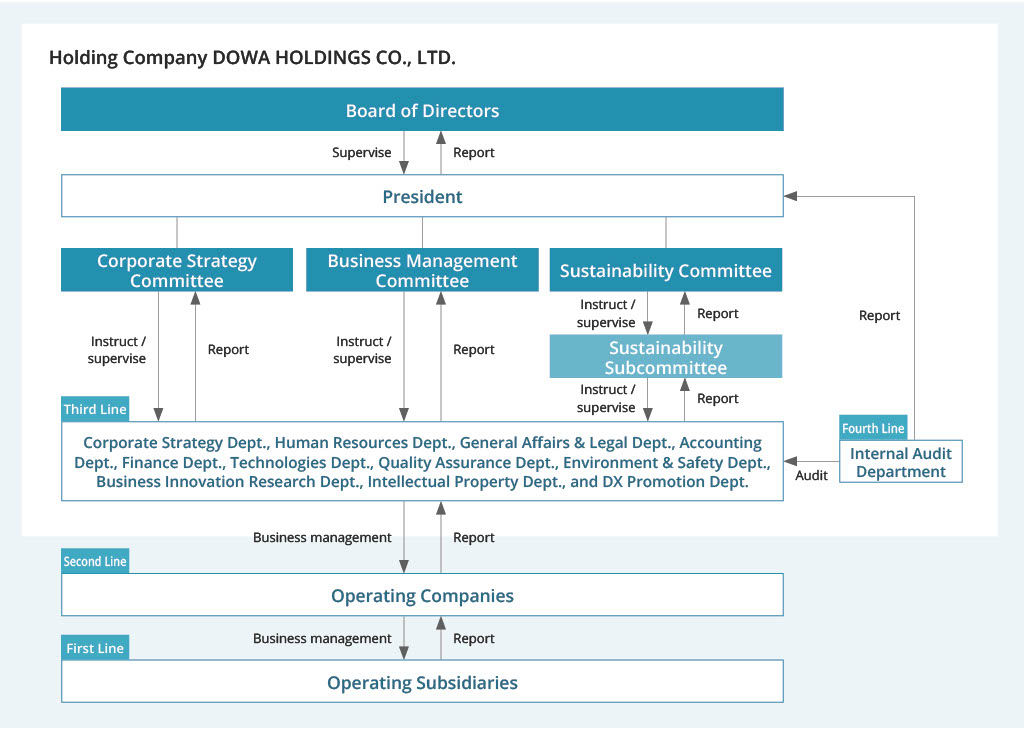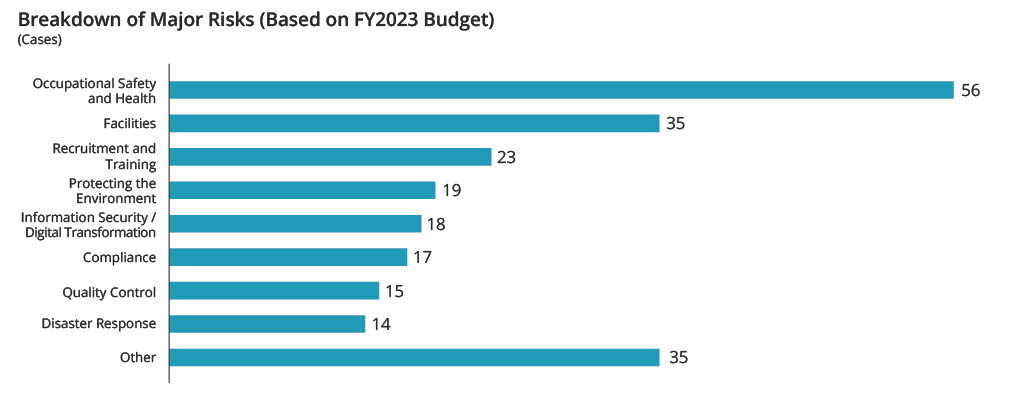The DOWA Group engages in making its risk management more sophisticated to prevent situations that could have a major impact on its business and to prevent or mitigate damage in the unlikely event such a situation comes to pass. In addition, we will continue efforts to enhance and perfect our risk management flow, which involves identifying apparent and potential risks at each operating company, implementing countermeasures, reviewing them, and conducting audits.
We classify risk into four categories: strategic risk, economic risk, operational risk, and hazard risk. Each classification includes scenarios and integrated risk management with reference to COSO and JISQ2001. The status of risk management is mainly overseen by the Corporate Strategy Committee and Business Management Committee for strategic risks and economic risks, while the status of risk management for operational risks and hazard risks is overseen by the Sustainability Committee. In particular, under the umbrella of the Sustainability Committee, the Sustainability Subcommittee, chaired by the director of the Corporate Planning Office, has been established to strengthen various sustainability activities, including the promotion of risk management. Furthermore, any matters deemed important at each committee are reported to the Board of Directors for oversight.
We are a company with a Board of Auditors and appoints external directors and external auditors who monitor and supervise the Company's business operations from an independent and impartial standpoint. Our risk management system is separated from the Board of Auditors.

The Group has established a risk management system based on the Four Lines Model for internal control, modeled on three lines of defense. The Operating subsidiaries responsible for production and other operations (first line) and the Operating companies that oversees them (second line) develop a risk management cycle that includes periodic risk assessments. In contrast, each DOWA Holdings division (third line) as the holding company provides necessary instructions, supervision, and support. Furthermore, the Internal Audit Department of DOWA Holdings (fourth line) conducts internal audits to evaluate the effectiveness of these measures.

|
Classification |
Description |
Specific Risks |
Response |
|
Strategic Risks |
Market Fluctuation Risks |
|
|
|
Climate Change Risks |
|
|
|
|
Economic Risks |
Price Fluctuation Risks |
|
|
|
Operational Risks |
|
|
|
|
Environmental Risks |
|
|
|
|
Quality Risks |
|
|
|
|
Labor Shortage Risks |
|
|
|
|
Regulatory Risks |
|
|
|
|
Hazard Risks |
Information Security Risks |
|
|
Starting from fiscal 2022, we have begun implementing a Risk Management Plan to identify and evaluate business risks in accordance with the business environment. In accordance with this plan, each Group company identifies and evaluates the business risks surrounding it once a year and selects priority risks. Additionally, we develop countermeasures for the selected priority risks and incorporate them into the next fiscal year’s budget, thereby increasing effectiveness. A risk assessment conducted in fiscal 2022 identified 232 measures to address significant risks and were included in the fiscal 2023 budget.
These measures are shared at Groupwide meetings, such as the Sustainability Committee, and are executed with support from each DOWA Holdings department, operating companies, and business support companies. Additionally, by compiling the details of measures as past case studies, we are increasing their value as information assets within the Group. Furthermore, the Internal Audit Department of DOWA Holdings regularly visits business sites to provide individual feedback, ensuring the continuity of risk management efforts.

In order to avoid or minimize any risks that could affect our ability to conduct business in times of emergency, we have formulated business continuity plans (BCPs) for each region and business location in the event of damaging earthquakes; other natural disasters, such as typhoons and torrential rains, which have been occurring with increasing frequency in recent years; and widespread pandemics. In addition, we regularly conduct drills based on scenario planning for large-scale disasters, such as an earthquake directly under the Tokyo metropolitan area, to prepare for crisis response as an organization. Since the DOWA Group primarily engages in business-to-business transactions, disruptions along the supply chain will have a severe impact on the production and sales activities of customers receiving our services or products. Therefore, through CSR procurement, we regularly confirm with our major suppliers that they have in place a BCP to ensure that we can restore and continue business promptly. Outside experts will conduct a location risk survey at all production sites in Japan, assuming a wide range of natural disasters such as earthquakes, tsunamis, windstorms, floods, and landslides, and based on the results, we are reviewing the BCPs at each site.
The strengthening of information security is positioned as one of the Group’s most important management issues. Under the leadership of management, we are working to address information security risks from both software and hardware perspectives. We established a dedicated team to respond to cybersecurity incidents, and it quickly tackled the issue. We operate to a security system that can centrally monitor the security status of computers used at each of the DOWA Group’s bases. We are also working to systematically improve employees’ understanding of security through methods that include raising awareness through training and study sessions.


